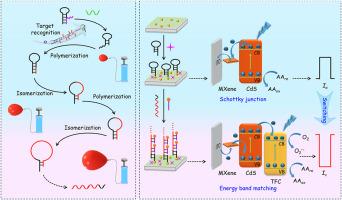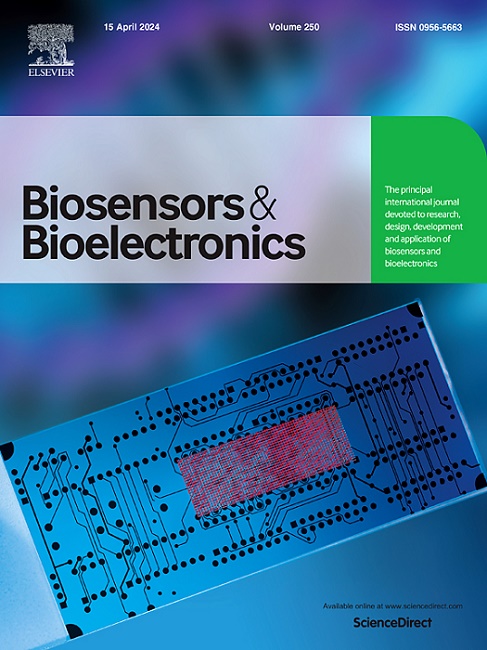DNA nanowire-enhanced polymerization isomerization cyclic amplification toward photocurrent polarity switching-based PEC biosensing
IF 10.7
1区 生物学
Q1 BIOPHYSICS
引用次数: 0
Abstract
The photocurrent-polarity-switching signal transduction strategy has provided an effective approach to improve the performance of photoelectrochemical (PEC) biosensors. Herein, we prepared a MXene/CdS nanocomposite based PEC biosensor and combined it with the polymerization and isomerization cyclic amplification (PICA)-assisted capture of a Fe3+ and Cu2+ co-coordinating 5,10,15,20-tetrakis(4-aminophenyl)porphyrin (TFC) based signal probe to develop a novel photocurrent-polarity-switching PEC biosensing method for the detection of kanamycin antibiotic. The PICA arose from the aptamer recognition-triggered release of an Mg2+-dependent DNAzyme (MNAzyme) strand to cleave its substrate. This reaction also triggered the assembly of a DNA nanowire decorated with abundant MNAzymes through hybridization chain reaction. Due to the DNA nanowire-enhanced PICA to extremely increase the probe capture at the biosensor and the good energy level matching between TFC and MXene/CdS, a strong polarity-switching based cathodic photocurrent response was produced to construct the signal transduction strategy. This not only excluded the possible false positive or negative signal interferences but also endowed a seven-order magnitude wide linear range and a very low detection limit of 0.03 fg mL−1 to the method. In addition, it also has convenient assay manipulation, high selectivity, outstanding repeatability, and excellent reliability, which determine its high potential promising for practical applications.

DNA 纳米线增强聚合异构化循环放大,实现基于光电流极性切换的 PEC 生物传感
光电流-极性开关信号转导策略为提高光电化学(PEC)生物传感器的性能提供了一种有效的方法。在此,我们制备了一种基于 MXene/CdS 纳米复合材料的 PEC 生物传感器,并将其与聚合和异构化循环放大(PICA)辅助捕获基于 Fe3+ 和 Cu2+ 共配位的 5,10,15,20-四(4-氨基苯基)卟啉(TFC)信号探针相结合,开发了一种新型的光电流-极性开关 PEC 生物传感方法,用于检测卡那霉素抗生素。PICA 的产生源于一种 Mg2+ 依赖性 DNA 酶(MNAzyme)链的识别触发释放,以裂解其底物。这一反应还通过杂交链反应触发了用大量 MNAzymes 装饰的 DNA 纳米线的组装。由于 DNA 纳米线增强了 PICA,从而极大地提高了生物传感器对探针的捕获率,而且 TFC 与 MXene/CdS 之间的能级匹配良好,因此产生了强烈的基于极性切换的阴极光电流响应,从而构建了信号传导策略。这不仅排除了可能出现的假阳性或阴性信号干扰,还使该方法的线性范围达到了七个量级,检测限低至 0.03 fg mL-1。此外,该方法还具有操作简便、选择性高、重复性好、可靠性高等特点,因此在实际应用中极具潜力。
本文章由计算机程序翻译,如有差异,请以英文原文为准。
求助全文
约1分钟内获得全文
求助全文
来源期刊

Biosensors and Bioelectronics
工程技术-电化学
CiteScore
20.80
自引率
7.10%
发文量
1006
审稿时长
29 days
期刊介绍:
Biosensors & Bioelectronics, along with its open access companion journal Biosensors & Bioelectronics: X, is the leading international publication in the field of biosensors and bioelectronics. It covers research, design, development, and application of biosensors, which are analytical devices incorporating biological materials with physicochemical transducers. These devices, including sensors, DNA chips, electronic noses, and lab-on-a-chip, produce digital signals proportional to specific analytes. Examples include immunosensors and enzyme-based biosensors, applied in various fields such as medicine, environmental monitoring, and food industry. The journal also focuses on molecular and supramolecular structures for enhancing device performance.
 求助内容:
求助内容: 应助结果提醒方式:
应助结果提醒方式:


